#Dragon taxonomy
Text
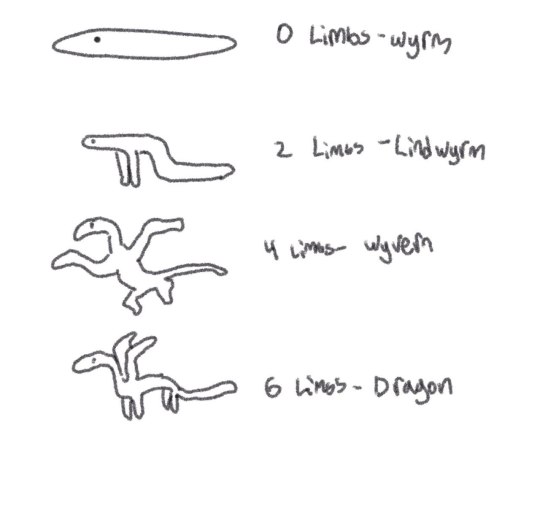
Ok so your basic Animal can be categorized as a Wym (0 limbs), a Lindwyrm (2 limbs), Wyvern (4 limbs), or a Dragon (6 limbs)
190 notes
·
View notes
Text
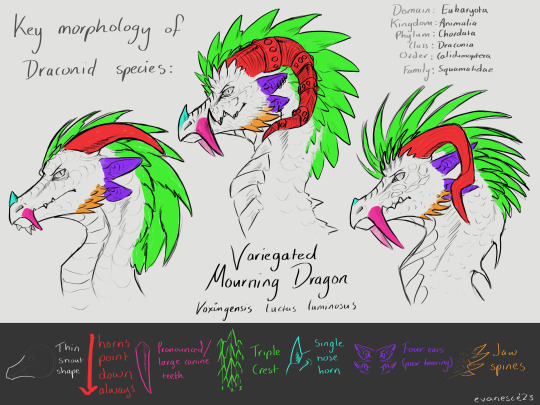
So I’ve been designing a taxonomic system for dragons… This is a little guide for head & face morphology for my sona’s species! She’s the one in the middle, called a Variegated Mourning Dragon (Voxingensis luctus luminosus). A subspecies of the Common Mourning Dragon, luminosus are much more flashy in colours and decoration. Mourning dragons, also called Howlers, are named as such for their calls, which sound like the wails of someone in mourning.
The four ears were from a mutation thousands of years in the past, and although it causes poor hearing (due to cramped ear canals and echo issues), it wasn’t detrimental enough to impact reproductive fitness and the ancestral species was prone enough to the mutation that it ended up becoming a permanent morphological aspect.
I’ll probably end up doing lots of full body and headshot morphology sketches like this as I’ve been listing all my dragon OCs’ taxonomy in a document. It’s so fun fr
#speculative biology#dragons#dragon taxonomy#some of the classifications will change over time as I progress with this and as I add subgroups#I’ll make a graphic explaining the different orders and families at some point too#anyway. taxonomy lovers CONVERGE *two people show up bc most people hate taxonomy*#evanesce#evanesce art
20 notes
·
View notes
Text
Dragon Taxonomy

Every so often I get struck by the urge to try and make a somewhat coherent taxonomy for the dragons, because if HTTYD is meant to be ‘our world’ and the dragons are animals instead of like, magical beings who appeared out of the ether, they must have evolved.
I went through three iterations of this cladogram before settling on one I’m happy with (for now), so allow me to break it down for y’all:
For those who don’t know, Linnaean taxonomy (which I am using here) has seven main ranks, as well as sub ranks, which start off broad/general and get more and more specific. They are Kingdom, Phylum, Class, Order, Family, Genus, and Species. Dragons are in the Kingdom Animalia, the Phylum Chordata and the Class…
Okay so I originally put them in their own class, but assuming they’re reptiles, they’d more likely be considered a subclass, or superorder, within the Class Reptilia. It’s up to interpretation.
There are two Orders grouped under Drakontes. The first is Nykteromorpha, which are all the dragon species with a wing membrane that attaches from the shoulders down to the hips. The second is Ornisteromorpha, which are all the dragon species with a wing membrane that attaches at the shoulder and sometimes partway down the ribs for more support. This is the biggest order.
Each Order has two suborders. As you can see from the cladogram, we have the bat winged dragons with short necks, the bat winged dragons with long necks, the bird winged dragons with short necks and the bird winged dragons with long necks.
So there are two Orders, four Suborders, and eight Families. The Families are named after the most well known dragon species in each of those groups, e.g: Nadderidae, Furidae and Groncklidae.
Four of those Families are in turn split into two subfamilies, for the dragons that (I think) are more closely related to the titular species, and the dragons that are less closely related to them. For example, dragons that are most closely related to Furies are in the subfamily Furinae, whereas those less closely related are in the subfamily Parafurinae, meaning ‘almost/close to alike Furies’.
I could be totally off about this (there’s literally no way to tell) but I tried to base it on what I know of real evolution and taxonomy, and on the dragons body plans rather than shared features. Dragons with similar physical characteristics seem more likely to be related than dragons that look almost nothing alike and just happen to have certain abilities in common, such as flicking spines.
I think that pretty much sums everything up. Thanks for reading!
17 notes
·
View notes
Text
On the one hand, it's true that the way Dungeons & Dragons defines terms like "sorcerer" and "warlock" and "wizard" is really only relevant to Dungeons & Dragons and its associated media – indeed, how these terms are used isn't even consistent between editions of D&D! – and trying to apply them in other contexts is rarely productive.
On the other hand, it's not true that these sorts of fine-grained taxonomies of types of magic are strictly a D&D-ism and never occur elsewhere. That folks make this argument is typically a symptom of being unfamiliar with Dungeons & Dragons' source material. D&D's main inspirations are American literary sword and sorcery fantasy spanning roughly the 1930s through the early 1980s, and fine-grained taxonomies of magic users absolutely do appear in these sources; they just aren't anything like as consistent as the folks who try to cram everything into the sorcerer/warlock/wizard model would prefer.
For example, in Lyndon Hardy's "Five Magics" series, the five types of magical practitioners are:
Alchemists: Drawing forth the hidden virtues of common materials to craft magic potions; limited by the fact that the outcomes of their formulas are partially random.
Magicians: Crafting enchanted items through complex manufacturing procedures; limited by the fact that each step in the procedure must be performed perfectly with no margin for error.
Sorcerers: Speaking verbal formulas to basically hack other people's minds, permitting illusion-craft and mind control; limited by the fact that the exercise of their art eventually kills them.
Thaumaturges: Shaping matter by manipulating miniature models; limited by the need to draw on outside sources like fires or flywheels to make up the resulting kinetic energy deficit.
Wizards: Summoning and binding demons from other dimensions; limited by the fact that the binding ritual exposes them to mental domination by the summoned demon if their will is weak.
"Warlock", meanwhile, isn't a type of practitioner, but does appear as pejorative term for a wizard who's lost a contest of wills with one of their own summoned demons.
Conversely, Lawrence Watt-Evans' "Legends of Ethshar" series includes such types of magic-users as:
Sorcerers: Channelling power through metal talismans to produce fixed effects; in the time of the novels, talisman-craft is largely a lost art, and most sorcerers use found or inherited talismans.
Theurges: Summoning gods; the setting's gods have no interest in human worship, but are bound not to interfere in the mortal world unless summoned, and are thus amenable to cutting deals.
Warlocks: Wielding X-Men style psychokinesis by virtue of their attunement to the telepathic whispers emanating from the wreckage of a crashed alien starship. (They're the edgy ones!)
Witches: Producing improvisational effects mostly related to healing, telepathy, precognition, and minor telekinesis by drawing on their own internal energy.
Wizards: Drawing down the infinite power of Chaos and shaping it with complex rituals. Basically D&D wizards, albeit with a much greater propensity for exploding.
You'll note that both taxonomies include something called a "sorcerer", something called a "warlock", and something called a "wizard", but what those terms mean in their respective contexts agrees neither with the Dungeons & Dragons definitions, nor with each other.
(Admittedly, these examples are from the 1980s, and are thus not free of D&D's influence; I picked them because they both happened to use all three of the terms in question in ways that are at odds with how D&D uses them. You can find similar taxonomies of magic use in earlier works, but I would have had to use many more examples to offer multiple competing definitions of each of "sorcerer", "warlock" and "wizard", and this post is already long enough!)
So basically what I'm saying is giving people a hard time about using these terms "wrong" – particularly if your objection is that they're not using them in a way that's congruent with however D&D's flavour of the week uses them – makes you a dick, but simply having this sort of taxonomy has a rich history within the genre. Wizard phylogeny is a time-honoured tradition!
#gaming#tabletop roleplaying#tabletop rpgs#dungeons & dragons#d&d#worldbuilding#taxonomy#phylogeny#media#literature#history#literary history#death mention
3K notes
·
View notes
Text
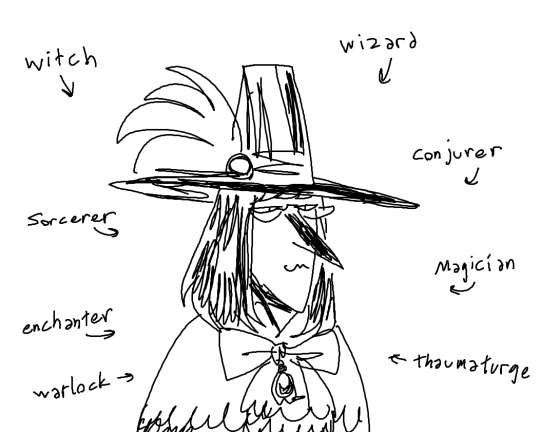
what's in a name
#laistrygon#i find getting nitpicky about terms like this about as arbitrary as dragon taxonomy#parry hotter really wrecked shit with its gender binary nonsense hhhh#witches can be any gender!!!!!!#ok lais is already genderfucky as it is but that's beside the point#and i feel like i need to specify this is about these terms being used in fictional settings hhhh#i don't really care how you use them tho#i'm personally *points at wyvern* dragon#*points at any magic user* wow a witch
71 notes
·
View notes
Text
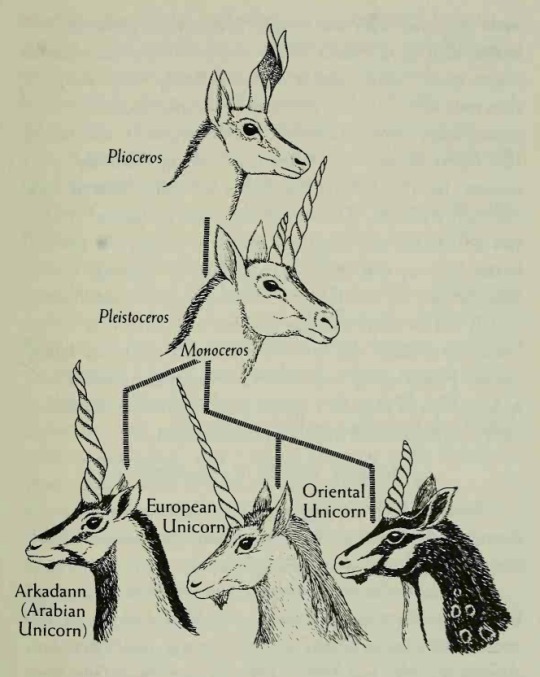
Species of unicorns (with typo).
From Dragons and Unicorns: A Natural History by Paul and Karin Johnsgard.
494 notes
·
View notes
Text

It’s finally here! The new and improved 2023 version of my Piscine wyverns, most leviathans, and true elder dragons phylogenetic tree.
There is quite the substantial difference between this version and the older ones. Each species profile is also more in depth than my last tree, the flying wyvern tree, because there’s a lot more room for speculation in these monsters. A lot of this is also recontextualizing and reworking many outlandish traits some of these monsters have and basically giving a lot of canon/what some of the hunters guild tells us the middle finger. Some of the scientific names for the families were made by my fellow poopenshitter TheCuriousOne. They came up with the names for their own tree and allowed me to use some of these names too.
Because the written description is almost 100,000 characters long, I had to put it in a google doc that you can read here! I even added a chapter index so you can skip to the families you want to read.
This is probably the most in depth monster hunter cladogram on the internet
#monster hunter#monster hunter biology#monsterhunter#monhun#speculative evolution#speculative biology#speculative zoology#speculative anatomy#phylogeny#phylogenetics#phylogenetic tree#taxonomy#cladogram#cladograms#elder dragons#piscine wyverns#leviathans#monster hunter rise#monster hunter world
104 notes
·
View notes
Text
I need some opinions on this
A reptile cannot regulate its own body temperature, lays eggs, and cannot produce milk.
A mammal can regulate its own body temperature, may lay eggs, and produces milk.
If a dragon can regulate its own body temperature (via internal autonomous function of the fire sac), lays eggs, and does not produce milk:
34 notes
·
View notes
Text
IF i'm being honest the obsession with "is xyz media's dragon a dragon or a wyvern?" is kind of unbearable to me. like i love fantasy taxonomy and spec bio but honestly that's not what a lot of that nitpicking is, it's usually just trying to apply a category at large to a number of various different media regardless of context. sometimes it just doesn't make sense to harp on this categorization every time you see a dragon in fiction
#on top of that there is very little historical/folkloric basis to suggest that a 'wyvern' is a SIGNIFICANTLY different category of dragon#from what i could find when i looked into this a while back it seems to be mostly a distinction in heraldry#which is not insignificant to informing the idea of a fictional taxonomy but like it has other purposes first and foremost
7 notes
·
View notes
Text
When people refer to the races of dnd as different species
But like
They can produce fertile offspring with each other, therefore are the same species
Assuming, of course, that the taxonomy works the same as our world.
This is to say that if I played a dnd campaign I would hold these things to scrutiny. Are elves, orcs, dwarves, and humans the same species? Or can any living thing breed with any other living thing? Maybe that’s a trait unique to only humans (a common trope I saw researching this, which is funny because even in dnd humans can’t stop mating with anything that moves).
#dnd#semantics#taxonomy#if I was a dnd player my dungeon master better be so good at obscure details or so help me god I’m getting a refund#text post#randyposting#dungeons and dragons
20 notes
·
View notes
Text
HOW TO NAME YOUR DRAGON
(in Latin)
Disclaimer
I'm not some kind of expert in Latin or anything like that, but I have experience in taxonomy for my dragon project, as well as biology education. Therefore, here I want to share some basic principles that will help you avoid obvious mistakes.
1. Google translator is your enemy, dictionaries are your friends
Google translate is not good at Latin. There you can occasionally check some roots if you cannot use a dictionary, but you should use it with great care and only if you already have some knowledge of Latin. Otherwise, the result is likely to be completely wrong.
I use some online Russian-Latin dictionaries, but I will not give any specific links, because all dictionaries are basically the same.
2. Taxonomy has rules
The scientific name of a species is binomial, that is, it consists of two words: the name of the genus to which the given species belongs, and the second word, called the species epithet in botany, and the species name in zoology.
The first word is capitalized, the second is lowercase.
Both words are in italics in the text.
The first word is a singular noun; the second is either an adjective in the nominative case, agreed in gender (masculine, feminine or neuter) with a generic name, or a noun in the genitive case.
Sometimes the second word can be a noun in the nominative case, which may not agree in gender with the first word, but this option is not common and I did not use it in my project.
The scientific names of dragons of celestial metals have both parts capitalized (Draco Solis, Draco Mercurii) only as an exception, as their species names refer to astrological Planets, and in my setting astrology plays an important role, however in terms of real taxonomy this is wrong.
In addition, most of my dragons have trinomial names, which is also related to their special position in the taxonomy.
Usually, for the names of species, I used the variant noun + noun in the genitive case, and for the names of subspecies I used adjectives.
For example:
Wyrmis platini regius
Serpens aeris nitentis
Guivrus phosphori niger
It should be remembered that botanical and zoological systematics have differences. In my project, I used some middle option, since dragons belong to a separate kingdom (for example, I used the term “epithet” instead of the term “name”). If your species are, for example, animals, then you need to follow precisely the zoological rules.
In fact, even in real taxonomy, there are some “mistakes” and deviations from the system, which are due to traditions and habits, however, the “it happened” card should be used with caution.
3. Noun gender
Nouns in Latin have a gender. In the dictionary, next to each noun, you can find an indication of its gender (masculine, feminine, or neuter), according to which the adjective should change.
For example:
Draco, onis m
The letter m means that the word is masculine.
The forms of adjectives are also indicated in dictionaries (often only the new ending is indicated).
For example:
niger, nigra, nigrum
ruber, bra, brum
aureus, a, um
Therefore, any option other than Draco niger, Draco ruber, or Draco aureus would be incorrect.
In English, it is difficult to convey the nuances, but in Russian the fallacy of the combination Draco nigra - “Дракон черная” will be obvious to everyone.
4. Parts of speech
An adjective is not a noun. I realize how self-evident this sounds, but it's very important for translating into Latin from English. In English, the word “water” can be both an adjective and a noun, so the spelling “water dragon” is absolutely correct, but in Latin you cannot just write Draco aqua, because in translation it will literally mean “dragon”, “(the) water” . The correct variant would be either Draco aquaticus or Draco aquae
5. Cases
Fortunately for you and me, in the context of taxonomy, we only need the genitive case, the form of which is always indicated in dictionaries (since it determines the declension).
Same example:
Draco, onis m
The genitive form would be “draconis”
6. Don't forget the year and the author
You probably noticed that after the name of a species or even just a genus there are other words. Most often you can see (Linnaeus, 1758) or L. (1753) there. The fact is that the names of taxa are not something given to us by God. They were invented by people, and therefore the full name of each species and genus includes the surname of the person who named it (but not necessarily discovered) and the year when this name was published. Many species were named by Linnaeus, so the examples above are the most common. The first option is used in zoology, and the second in botany. In my project, I used a zoological variant, often referring to Linnaeus and other real scientists, but also inventing new surnames.
7. Additional notation
It often happens that one scientist described a species as part of one genus, and then someone transferred it to another taxon. Or the species name itself has not yet been approved. Or someone described the species in the work of another scientist. Or the name has synonyms. Or is it important for you to specify the variety. Or many other necessary notes.
That's why there are additional notations. Again, they differ in zoology and botany (if I remember correctly, I mainly followed the zoological variants in the Guide), and you can find a complete list of them on Wikipedia under the query “Обозначения, используемые в наименованиях таксонов” (unfortunately, the version of this articles in English are very incomplete)
It is not necessary to add something similar to the name of each species, however, if you have a whole group of creatures, then such additions will bring variety and realism.
Here are some examples from my project:
Guivrus sulfuris vulgaris ined.
Caudaesus silicii bichromus [syn. Caudaesus silicii quarzeus var. bichromus] Sewergin, 1810
Serpens aeris nigra Bert, 1851 ex Tenore, 1849
Serpens ferri arsenicea Morout in Alcorn, 1812
Serpens stanni marina (Linnaeus, 1758) Schnering, 1983
Wyrmis aluminii lotus [syn. Wyrmis aluminii corundeus var. lotus] (Linnaeus, 1758) Wiltse, 1868
8. Other taxa
In addition to genera and species, there are also other taxa. And if taxa below the species are found relatively infrequently, then families, orders, classes, types and kingdoms are a necessary part of taxonomy. Of course, you can always assign your creature to an already existing class or even family, however, if you plan to create your own taxa, you should first check the endings accepted in a particular science.
For example, for orders of animals, the endings -iformes and -ida are used, and for the orders of plants, fungi, bacteria, and archaea, -ales.
That's all. If you have any questions, I will be happy to answer them (but remember that I am essentially only an amateur and English is not my native language, so I may not know where to get certain sources in this language)
#dragons#dragon#dragons of alchemy#dragon identification guide#taxonomy#speculative biology#latin#text#long reads#alchemy
129 notes
·
View notes
Text
not to be sillybrained over what I actually consider a bit of an emotional event i'm going thru rn but. i'm packing up my collection of dragon figures while moving, wrapping em all nice up in bubblewrap so they're safe and won't break in transit—and im realizing a not insignificant amount of these are dragons that have saddles on them.
...empty saddles because i threw out or stuffed the rider in a drawer. why would a dragon need a rider. it not a GUY shelf its a DRAGON shelf. Even as a kid i thought they were boring having some guy on their backs. so much cooler when they're on their own
and well. i had that silly guy thought. About laios touden,
#in my minds eye hes looking at the empty saddle while im yapping about where i got each one and 'ohhhhhhhhhhhhhhhuh'#he would. he woulr understand my silly collection........hewould want me to double wrap them im bubblewrap so i dont worry theyll break...#what am i TALKING about. hhwhuggdhd. help me laios laios help me#new question WOULD he argue about wyvern-dragon taxonomy or accept the term dragon is too broad to say a wyvern isnt one but not viceversa#i want him. sorry i like my dragon collection a lot and putting em away... 'hey. don't be sad. knight guy' thanks brain i needed that#is this far enough i can canon tag the series for sorting purposes without putting embarassing selfship in there. im gonna say yeah#dungeon meshi#armour clanking#beloveds tag#POSTS THIS AND RUNS dont look at me. kicking my feet
3 notes
·
View notes
Text
HTTYD: Dragon Taxonomy
Kingdom: Animalia
Phylum: Chordata
Clade: Amniota
Clade: Synapsida
Clade: Therapsida
Clade: Dercomaiia
Clade: Draconomorpha
Class: Dracontes
Superorders: 2
Orders: 8
Families: 26
Superorder
Order
Family
Gronckle
Hotburple
Quaken
Goregutter
Red Death
Bewilderbeast
Cavern Crasher
Family
Eruptodon
Sentinel
/
Order
Family
Mudraker
Thunderclaw
Family
Snow Wraith
Snifflehunch
Windgnasher
Family
Snafflefang
Shovelhelm
Moldruffle
/
Order
Family
Hideous Zippleback
Scauldron
Family
Hobgobbler
Submaripper
Family
Buffalord
/
Order
Family
Night Fury
Light Fury
Sand Wraith
Woolly Howl
Family
Stormcutter
/
Order
Family
Thunderdrum
Shellfire
Family
Singetail
Smothering Smokebreath
Changewing
Snaptrapper
/
Order
Family
Flightmare
Sweet Death
Shockjaw
Firewyrm
Thunderpede
Flame Whipper
Family
Shadow Wing
Family
Sandbuster
Slitherwing
Family
Grapple Grounder
Grim Gnasher
Family
Egg Biter
Deadly Nadder
Scuttleclaw
Family
Dramillion
Family
Rumblehorn
Triple Stryke
Deathgripper
/
Superorder
Order
Family
Razorwhip
Windstriker
Death Song
Slithersong
Family
Devilish Dervish
Thornridge
Threadtail
Family
Monstrous Nightmare
Armorwing
Boneknapper
Night/Cave/Fire Terror
Prickleboggle
Terrible Terror
Family
Typhoomerang
Silver Phantom
Timberjack
/
Order
Family
Sword Stealer
Shivertooth
Windwalker
Groncicle
Hackatoo
Seashocker
Family
Hobblegrunt
Skrill
Whispering Death
Screaming Death
Family
Raincutter
Sliquifier
Tide Glider
Speed Stinger
2 notes
·
View notes
Note
Your post about the origin of paladin in D&D made me think of a long standing pet peeve of mine - when people insist that a knight, guarding a palace, without employing holy magic, is not a "real paladin" in modern media. Do you have any particular thoughts on the way that D&D has so heavily coloured definitions of things in this way?
(With reference to this post here.)
It's just basic lack of media literacy. People who get hung up on how Dungeons & Dragons defines its character classes are in the same boat as folks who misidentify bog-standard sword and sorcery fantasy tropes as Discworld references because they've only ever been exposed to the genre via Terry Prachett's parodies of it, or folks who see colour-coded alchemical symbols and think they've caught you name-checking Homestuck – they all need to read a second book!
#gaming#tabletop roleplaying#tabletop rpgs#dungeons & dragons#d&d#media literacy#taxonomy#arrant pedantry
2K notes
·
View notes
Text
About dragons, specially ones with 4 legs and 2 wings such as in the Wings of Fire book series or How to Train Your Dragon movies.
TL;DR : Dragons are a different class than reptiles but evolved from reptiles. They evolved wings first and then evolved front limbs, letting them have 6 limbs.
They have 6 limbs, unlike any other animal, and this had never been evolved in animals before. This bothered me to no end as reptiles don't have this many limbs. I've been trying to wrap my head around this for a while now but I think I've come up with a good enough biological explanation for a make believe fantasy creature:
Dragons have to be their own class, such as mammals, birds, or amphibians. They seem like reptiles, as they'd be most closely related to them, but they have to be their own class, as having a completely different number of limbs is a major difference. At some point in time, dragons and reptiles would've split when a reptile evolved wings of some sort and also another pair of limbs, which I explain after this poorly edited cladogram of the classes:

Dragons being a different class would explain the many different species of dragon in some media, such as the aforementioned Wings of Fire or How to Train Your Dragon.
As to how I think this would happen, I believe that, like I said, some reptile species evolved wings and more limbs and that was the first dragon, but that's not exactly the case. We have seen animals evolve wings from limbs, but never wings out of nowhere, that isn't how evolution works. So I believe that this hypothetical reptile evolves front-limb wings for gliding at first (similar to the draco in concept but a bone structure more like bats perhaps), and eventually they become powerful enough for flight. This reptile would then have experience some environmental pressure that causes it to also need front limbs, so individuals with small beginnings of front limbs would survive. Natural selection, evolution, adaptations, etc, etc. This reptile now has wings that evolved from front limbs and a new pair of front limbs, so it is now a dragon. Essentially, some reptile evolved wings and then evolves the front limbs afterwards.
This seems the most plausible, as we have never seen wings evolve by themselves in animals, they always come from limbs that existed first, which I've already said.
I think that maybe some reptile species population gets geographically isolated in a mountainous region with unstable ground they aren't fit to survive in. The first thing that evolved is wings to fly above the unstable terrain, and then the second thing they evolve is limbs to have stable footing when they do have to land. Evolving wings is more important as it allows them to stay off the ground and save themselves from falls, so this happens first, and then evolving another set of limbs helps them when they inevitably have to land, so both traits evolve in the correct order. This explains why dragons love mountains in media, too. It's the land they're best suited to traverse as they evolved specifically for it.
Sorry this went on a long time and probably repeated several points! If I got anything wrong such as biology terms or spelling mistakes, tell me and I'll fix it! I just needed to get this off of my chest as I finally came up with an answer to this after like a year of thinking about it. No offense to any series with dragons like this!
#wings of fire#never actually read that#how to train your dragon#fantasy taxonomy#dragons#cladogram#taxonomy
6 notes
·
View notes
Text
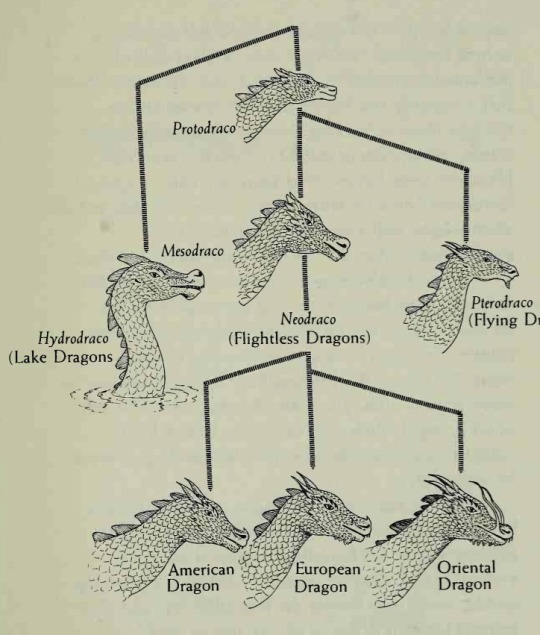
Species of dragons.
From Dragons and Unicorns: A Natural History by Paul and Karin Johnsgard.
473 notes
·
View notes